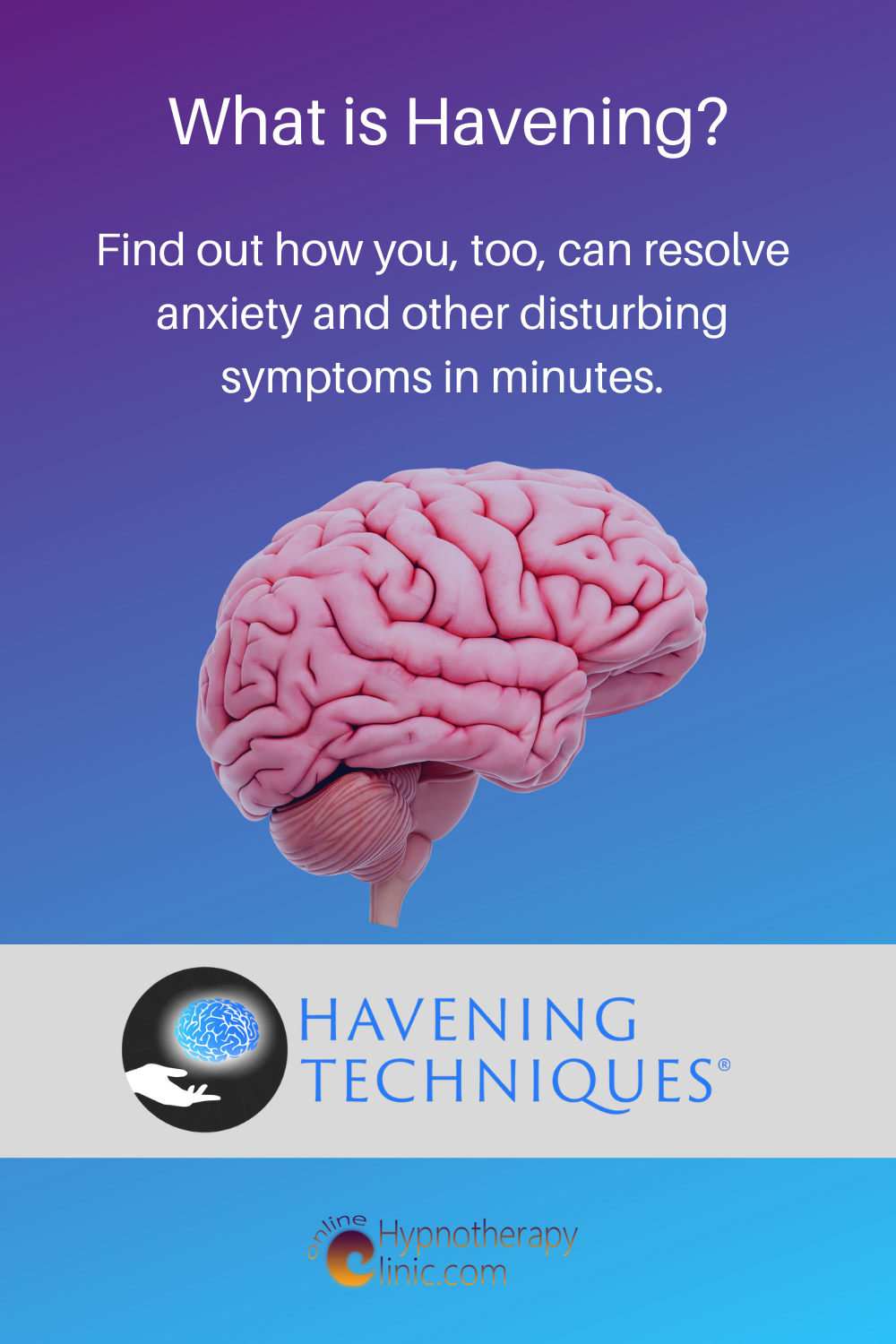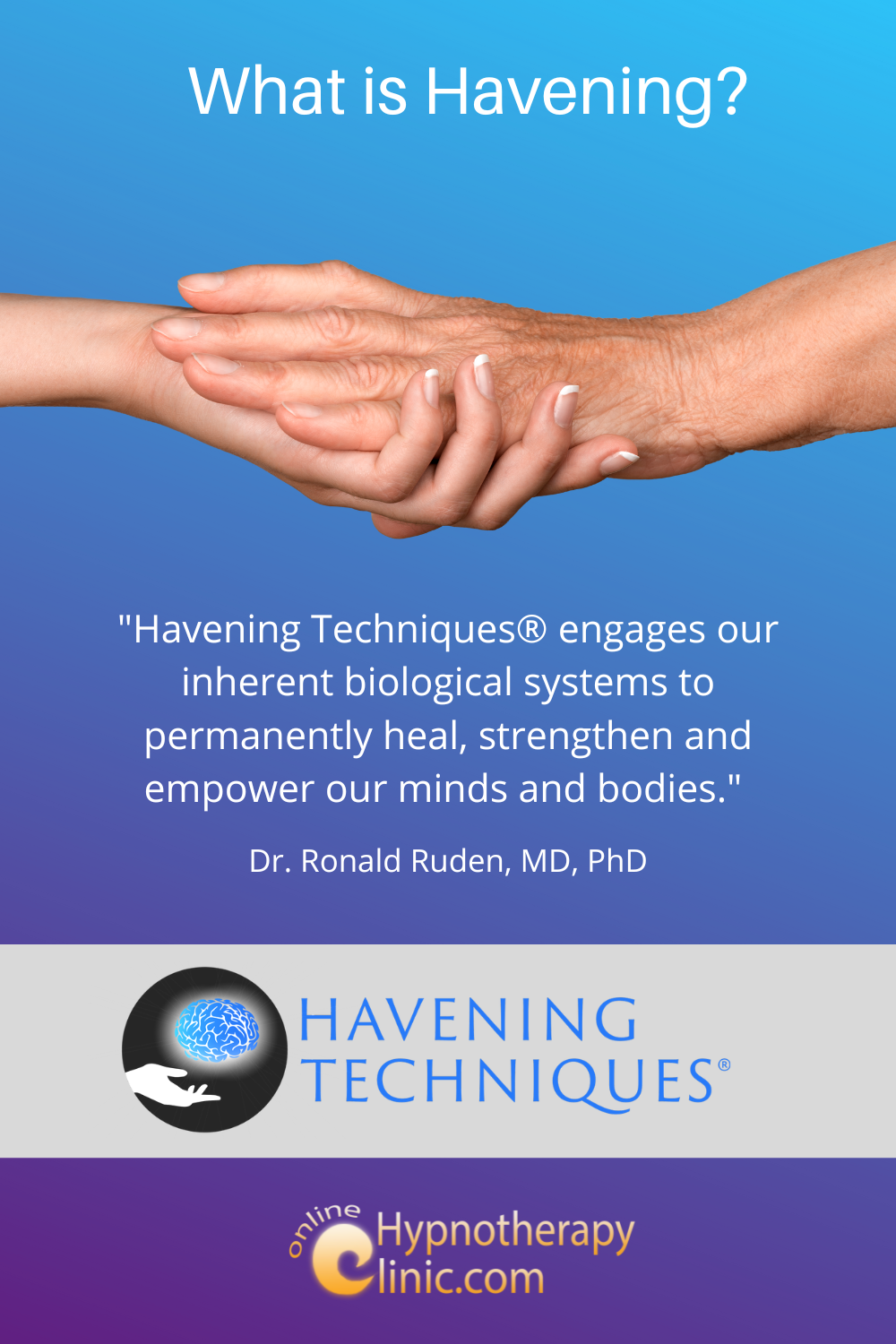What is Havening?
What is Havening? At first many people are puzzled by the odd word.
The term Havening was coined by its co-founder, Dr, Ronald Ruden and it refers to Havening's unique ability to create a 'safe haven' for the mind so that we can deal with difficult issues while clients are comfortable.
What is Havening?
What is Havening?
Havening is what we call a psychosensory modality.
Havening is not a therapy, it's not psychotherapy, it's a standalone piece, a standalone modality that very very specifically targets issues in the way that I will introduce shortly.
We use sensory signals in Havening, predominantly touch in order to influence psychological processes.
This Havening touch on the other interventions which include eye movements are all designed to aid the production of delta brainwaves.
These Delta brainwaves have the function of creating a lovely relaxing effect that makes our brain feel safe. This is very important for when we are processing trauma with clients because it keeps them nicely comfortable in the process.
The relaxing effect also helps the brain when we absorb new information. And that piece is very helpful in resilience building with our clients.
As well as the Delta brainwaves you can see there are four other major brain waves present in the human brain at different times.
They all have different functions. You can see the Delta brainwaves is the slowest of them all. The other important brainwave for Havening is the gamma brainwave.
The Gamma and Delta brainwaves are nearly the opposite end of a spectrum, the Gamma brainwave is present during situations when we're exposed to some kind of danger or something that's perceived as threatening.
And our brain has determined that survival is at stake. So we must get ready to defend ourselves. There is some sense of danger around the dead of brain wave.
We've already mentioned this lovely sense of safety, it's okay, it's safe. And each of these brain waves result in different neural chemical processes. So let's look first at what happens when we have a gamma brainwave present.
The gamma brainwave, you can see it on the number two is produced in situations where we have a threatening event.
This event has a meaning of some kind of loss of attachment, something where that's very important to us that we are attached to is under threat, and also required as a certain vulnerability in the neural landscape at this point, that makes us likely to encode this memory in a particular way. And the sense of inescapability so it feels like you have no control.
You can't get away from this.
And what set in motion then with the Gamma brainwave peering under these particular circumstances, is an outpouring of stress neurochemicals like cortisol and noradrenaline, which will keep pain levels low, and also dopamine, which is crucial and learning.
On the number three, you can see them the very, very specific thing that happens with these neural chemical processes.
AMPA receptors will be what's called potentiated on the cell surface in the lateral amygdala potentiated means they will be increased in number and in permanent.
And this happens by anchoring them to the cell surface with the help of phosphate molecules, which are the red guys here in my image anchoring the green guys to the cell surface.
The end result of that is what we call traumatic and recording of these memories, even though it happens in all situations.
Major- minor trauma, this particular principle is always the same. And it results in memories which are designed for permanent so that means the memory is always easily accessible at the slightest trigger that appears.
The biological function of that is that we never forget this dangerous event and that we can develop skills than to avoid it in future or so nature.
Hope Also very characteristic for these particular types of memories is the high emotional charge that these memories carry.
The idea here is that they will be flagged for a high attention that we will always deal with these types of triggers first, because they're crucial to our survival.
And hence this encoding involves flight fight freeze defensive rage responses, with huge emotional charge usually behind it.
Well, thankfully, these memories are not permanent, they are designed to be permanent, but they can actually with the help of happening be taken apart relatively easily.
So under number one, what we do is we invite in marginal recall. And this imaginal recall, brings forth a memory that has to be cleared, we then produce the lovely Delta brainwave under number two.
We do this with handling touch or any of the other interventions that we use. We then get an outpouring of other helpful neurochemical.
Some of them we have few good neuro chemicals, such as serotonin and oxytocin. Under number three, you can see what happens as the end result of these neuro chemical processes is that these AMPA receptors are indeed potentiated.
That means they are reduced the number they're reduced and permanent. They slide on the cell surface and are ultimately reabsorbed into the cell and recycled.
And on the very right hand side, you can see that the traumatic survival responses are dealing from the particular memory, the emotional charge will drop right down, the person starts feeling safe and the memory will be filed away as an ordinary memory, the priority levels will have been changed on that.
And hence, the emotional charge is gone.
And because inhaling, we have really peeled this process down to its very, very essentials, and the actual neurochemical essence of what happens, we can apply these very same processes that we use to many, many different issues.
And the list I'm going to give you now is by no means exhaustive. Let's start with fears and phobias that have the same type of encoding. Anxiety usually has an accumulation of these types of encodings at the bottom of it. So the same with low mood and depression, with low esteem, low confidence.
Eating Disorders, very important, of course, as we move to naming issues with more severity, that the practitioner is appropriately trained and qualified to support the release of these encodings or OCD behaviors, weight loss, psychiatric disorders, things like sexual dysfunction that can be very difficult to treat.
Any type of addiction will also have the same underlying and coding, so does chronic pain so do toxic emotions, and even conditions like chronic fatigue syndrome, some other auto immune diseases will can be improved by removing the stress underneath them.
And very, very useful of course, in resilience building and for high performance coaching, there are many coaches in the community that predominantly use that side of the skill set.
Thank you very much for watching. I hope this was helpful and answered your question: What is Havening?
Regards,

More About Havening
More About Havening
Havening und Havening Techniques Ausbildung auf Deutsch
Was ist Havening und wie könnte es Dir helfen, Dein Leben zu verändern?
Deutschsprachige Einführung zum Thema Havening.
Einführende Ausbildung in Havening Techniques®
Kostenfrei: zwei Stunden Videoinhalte für alle die neugierig sind.
Havening Techniques im Gespräch
Susanna Sweeney interviewt von Dr. Michelle Haintz. Wir reden über mein persönliches Erlebnis mit Havening, die Havening Methode und detailliert über die Havening Ausbildung.
Havening Interview zum Kennenlernen mit dem Klopftechnikverband (auf Deutsch)
Susanna Sweeney im Interview über die Havening Methode
Havening Techniques Interview (auf Deutsch)
Susanna Sweeney im Interview über die Havening Methode, die Havening Ausbildung und ihre eigene Reise mit Havening
Havening Techniques® Ausbildung auf Deutsch
Lernen Sie eines der modernsten und faszinierendsten Verfahren zur Auflösung von Traumasymptomen, Angstzuständen, chronischen Schmerzen und anderen Blockaden und zur Stärkung von inneren Ressourcen. Bequem von zu Hause- online.
Havening for Effective, Gentle and Permanent Change
What is Havening and how Could it Help you Change your Life?
This article gives a solid introduction to Havening that I recommend you read first.
Havening Touch- How to use it to Change your Life
Find out why Havening touch works so well and how to perform it at home to calm difficult emotions in minutes and build resilience.
Havening Therapy Compared to Psychotherapy
Find out how the lesser known Havening Techniques® compares to psychotherapy.
Dr. Ruden, Co-Creator of Havening in Interview with Susanna Sweeney discussing the history, philosophy and future of Havening Techniques.
Self Havening- How to use this Powerful Self Help Tool for Best Benefit
Find out how Self Havening could help you change your life for the better , and learn how to use it the right way so that you can get maximum benefit.
See the science and watch a client testimonial to see the amazing results Havening produces.
What is Havening? Find out about this cutting edge therapy modality that can help you with a vast range of issues including anxiety, low mood, low esteem, chronic pains, migraines and more
Havening Techniques- Interviews with the Founding Fathers
Meet Dr. Ron and Dr. Steve Ruden, founders of the Havening Techniques®, who- in two in-depth interviews, disclose the fascinating story of how this cutting edge psychosensory modality was developed.
Recent Articles
-
Havening Technique Training auf Deutsch
Apr 18, 25 02:59 AM
Havening Technique Training auf Deutsch- Details und Buchung -
Client Testimonials
Oct 06, 23 06:08 AM
Client Testimonials of my Online REPAIRenting® Program that uses various psychosensory approaches for safe and quick transformation -
Smoke Free Thanks to This Amazing Resource
Aug 02, 23 09:26 AM
Oh thank you for this simple resolution to all my worries! I feel like I have had a weight lifted off my shoulders. It is like cheating on giving up smoking.



New! Comments
What do you think? Leave a comment in the box below.